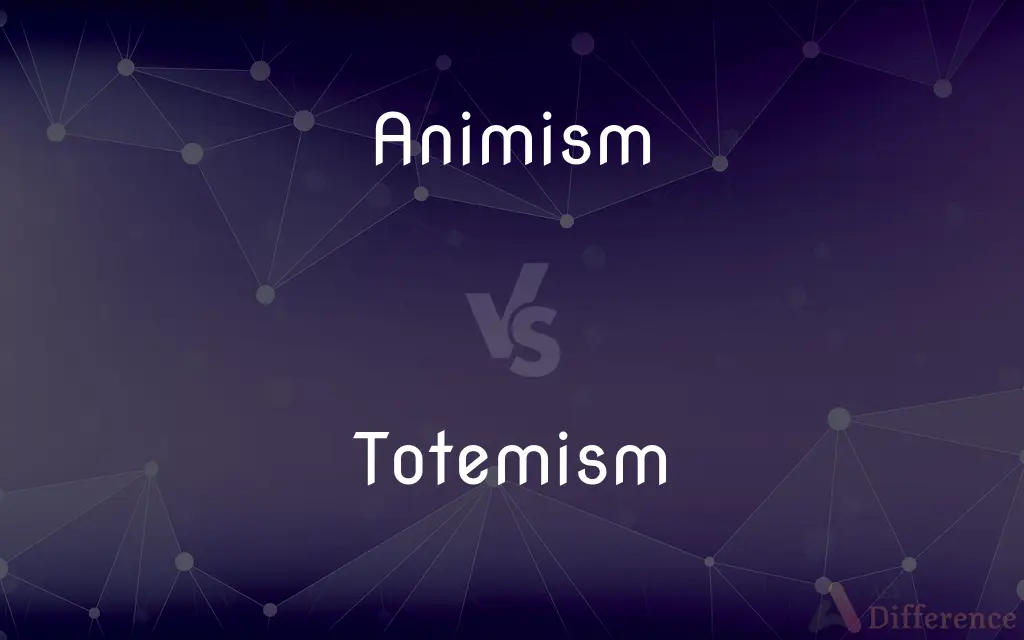Animism vs. Totemism — What's the Difference?
Edited by Tayyaba Rehman — By Urooj Arif — Updated on April 9, 2024
Animism sees every entity as spiritual and alive, while totemism assigns symbolic spiritual connections to specific animals or objects.

Difference Between Animism and Totemism
Table of Contents
ADVERTISEMENT
Key Differences
Animism is a belief system that posits all elements of the natural world, including plants, animals, and inanimate objects, possess a spiritual essence. This perspective views the universe as alive and interconnected, where humans are just one part of a larger, animate cosmos. Whereas totemism, a subset of animism, involves the belief in a mystical relationship between a group or an individual and a totem, which is often an animal or other natural figure. Totems serve as emblems or symbols of clans, families, or individuals, carrying spiritual significance and guiding social and religious practices.
In animism, the spiritual essence is not confined to living entities but extends to mountains, rivers, and man-made objects, attributing life and personality to them. This universality of spirit leads to a worldview that emphasizes respect for the environment and all its inhabitants. On the other hand, totemism focuses more narrowly on specific entities as totems, creating a direct and symbolic connection that influences the identity and practices of a group or individual.
Animism encourages practices and rituals that aim to communicate with or appease the spirits inhabiting the natural world, often through shamans or spiritual leaders who act as intermediaries. Meanwhile, totemism involves rituals and taboos specific to the totem, such as not eating the animal or plant the totem represents, to honor the sacred connection and maintain harmony within the community.
The concept of animism is broad and can be found in various cultures worldwide, from indigenous tribes in the Amazon to Shinto practices in Japan. Totemism, while also global, is particularly associated with indigenous peoples of North America and Australia, where it plays a crucial role in the social structure and spiritual life of communities.
Both animism and totemism highlight the deep connection between humans and the natural world, yet they differ in scope and practice. Animism’s broad spiritualism encompasses all aspects of life, while totemism’s focused symbolism serves to define and guide specific communities through their relationships with particular aspects of the natural world.
ADVERTISEMENT
Comparison Chart
Scope
Universal, applies to all natural and man-made entities
Specific, centers around particular animals or objects
Belief
Every part of the natural world has a spirit
Specific natural objects or animals have spiritual significance as totems
Practice
Involves rituals to communicate with or appease spirits
Involves rituals and taboos specific to the totem
Role
Guides general respect for and interaction with the environment
Guides social structure, identity, and practices within a group
Cultural Prevalence
Found in various cultures worldwide
Particularly associated with indigenous peoples of North America and Australia
Compare with Definitions
Animism
Attributes spiritual life to everything in the natural world.
In animism, the wind is often considered a living, spiritual being.
Totemism
Establishes a symbolic relationship between a group and their totem.
Totemic practices often involve wearing symbols of the totem animal.
Animism
Practices often involve rituals to communicate with the spirit world.
Animistic rituals might include offerings to the spirits of the land.
Totemism
A belief system where a natural object or animal is spiritually significant to a group.
In totemism, a clan might consider the eagle as their sacred symbol.
Animism
Emphasizes the spiritual interconnectedness of all life forms.
Animists see humans and nature as part of an interconnected spiritual web.
Totemism
Involves specific taboos, such as not harming or eating the totem animal.
If a clan’s totem is the salmon, members may be forbidden from eating salmon.
Animism
Belief that all natural objects and the universe itself have souls.
Animists believe that even rocks and rivers have spirits.
Totemism
Has a specific cultural significance, often related to identity and heritage.
Totemic symbols are prominently featured in the art and mythology of indigenous cultures.
Animism
Manifests in diverse ways across different cultures.
Animism shapes the spiritual practices of indigenous tribes in the Amazon.
Totemism
Plays a crucial role in defining the social structure of a community.
Totemism can dictate marriage rules within clans.
Animism
Animism (from Latin: anima, 'breath, spirit, life') is the belief that objects, places, and creatures all possess a distinct spiritual essence. Potentially, animism perceives all things—animals, plants, rocks, rivers, weather systems, human handiwork, and perhaps even words—as animated and alive.
Totemism
A belief in totems or in kinship through common affiliation to a totem.
Animism
The belief in the existence of individual spirits that inhabit natural objects and phenomena.
Totemism
The practice of establishing affiliation through totems.
Animism
The belief in the existence of spiritual beings that are separable or separate from bodies.
Totemism
(religion) The belief that a person or group has a special mystical relationship to a totem
Animism
The hypothesis holding that an immaterial force animates the universe.
Totemism
The system of distinguishing families, clans, etc., in a tribe by the totem.
Animism
A belief that spirits inhabit some or all classes of natural objects or phenomena.
Totemism
Superstitious regard for a totem; the worship of any real or imaginary object; nature worship.
Animism
A belief that an immaterial force animates the universe.
Totemism
Belief in the kinship of a group of people with a common totem
Animism
(dated) A doctrine that animal life is produced by an immaterial spirit.
Animism
The doctrine, taught by Stahl, that the soul is the proper principle of life and development in the body.
Animism
The belief that inanimate objects and the phenomena of nature are endowed with personal life or a living soul; also, in an extended sense, the belief in the existence of soul or spirit apart from matter.
Animism
The doctrine that all natural objects and the universe itself have souls;
Animism is common among primitive peoples
Common Curiosities
How does totemism influence art and culture?
Totemism influences art and culture through the use of totemic symbols in crafts, stories, and rituals, often serving to communicate cultural values and histories.
What is animism?
Animism is the belief that everything in the natural world, including inanimate objects, has a spiritual essence.
What role do totems play in totemism?
Totems act as symbols of clans or individuals, embodying their identity and guiding spiritual and social practices.
Is animism recognized as a religion?
Animism is more often considered a spiritual belief system rather than a structured religion, though it is a fundamental aspect of many indigenous religions.
How does totemism differ from animism?
Totemism is a specific form of animism that focuses on a symbolic connection between a group or individual and a particular natural object or animal considered a totem.
Can animism and totemism coexist in a culture?
Yes, many cultures incorporate both beliefs, with totemism serving as a more specific expression of the broader animistic worldview.
Can the concept of totemism be found in urban settings?
Yes, even in urban settings, communities or groups may identify with certain symbols or totems that reflect their shared values or heritage.
What are common practices in animism?
Common practices include rituals to communicate with or appease spirits, such as offerings or dances.
How do totemic taboos affect social behavior?
Totemic taboos, such as prohibitions against eating the totem animal, help maintain respect for the totem and can influence social norms and dietary practices.
How do animistic beliefs affect environmental attitudes?
Animistic beliefs often foster a deep respect for nature, encouraging practices that aim to live in harmony with the environment.
Are there any universal spirits or deities in animism?
While animism primarily focuses on localized spirits, some cultures also believe in universal spirits or deities overseeing more significant aspects of life.
How do animists view the afterlife?
Views on the afterlife vary widely among animistic cultures, with some believing in a spiritual realm where spirits of the dead reside.
Can someone adopt animism or totemism in modern times?
Yes, individuals and groups can and do adopt animistic or totemic beliefs, often as part of a broader interest in indigenous or nature-based spirituality.
Do totems have to be animals?
While animals are common totems, in some cultures, plants, geological features, or even ancestral figures can serve as totems.
How are shamans or spiritual leaders involved in animism?
Shamans or spiritual leaders often mediate between the community and the spirit world, conducting rituals and providing guidance based on their ability to communicate with spirits.
Share Your Discovery

Previous Comparison
Boilermaker vs. Welder
Next Comparison
Frigate vs. BrigAuthor Spotlight
Written by
Urooj ArifUrooj is a skilled content writer at Ask Difference, known for her exceptional ability to simplify complex topics into engaging and informative content. With a passion for research and a flair for clear, concise writing, she consistently delivers articles that resonate with our diverse audience.
Edited by
Tayyaba RehmanTayyaba Rehman is a distinguished writer, currently serving as a primary contributor to askdifference.com. As a researcher in semantics and etymology, Tayyaba's passion for the complexity of languages and their distinctions has found a perfect home on the platform. Tayyaba delves into the intricacies of language, distinguishing between commonly confused words and phrases, thereby providing clarity for readers worldwide.















































